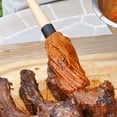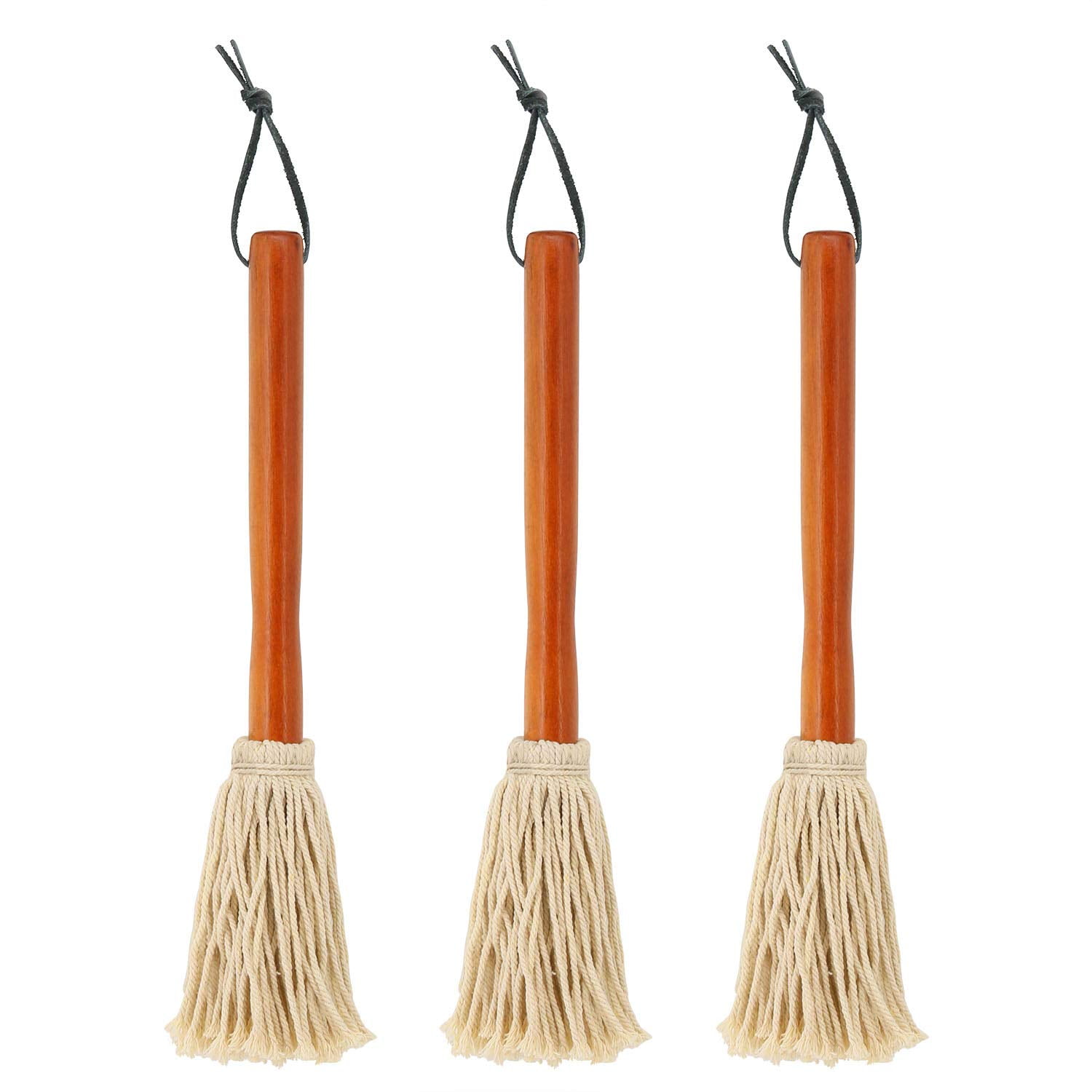Mop Sauce Vs. BBQ Sauce: What's The Difference? + Tips
What secrets do pitmasters guard, and how can you elevate your barbecue game at home? The answer lies in understanding the often-overlooked, yet crucial role of the "mop sauce" a technique that transforms ordinary barbecue into an extraordinary culinary experience.
Mop sauces, steeped in the traditions of Texas commercial pits, represent more than just a condiment; they are a testament to the art of barbecue itself. Historically, these sauces were a means of cooling the meat and, crucially, maintaining its moisture during long, slow cooking over coals. But, the skill isn't exclusive to the professionals of Texas.
| Feature | Details |
|---|---|
| Definition | A thin, liquid seasoning applied to meat during the cooking process, typically with a tool resembling a small kitchen mop. |
| Purpose | Adds flavor, helps create a crust (bark), and keeps meat moist. |
| Typical Use | Large cuts like pork butts, ribs, and brisket. Also used in South Carolina for whole hog BBQ. |
| Key Characteristics | Thin and runny consistency, unlike thicker barbecue sauces. Applied at regular intervals during cooking. |
| Ingredients (Common) | Water, apple cider vinegar, spices (chili powder, cayenne), brown sugar, etc. |
| Application Method | Using a brush or a miniature "mop" during the cooking process. |
| Main Difference vs. BBQ Sauce | Mop sauces are thinner and used during the cooking process; BBQ sauces are thicker and often applied towards the end of cooking or as a condiment. |
| Regional Variations | Texas style coffee mop sauces for briskets. South Carolina uses vinegar based mopping sauce for whole hog. |
| Famous Users and Mentions | Meathead (amazingribs.com founder and bbq hall of famer), Walter Jetton (Texas BBQ legend). |
The core distinction between a mop sauce and a typical barbecue sauce lies in their consistency and the timing of their application. A mop sauce, as the name implies, is thin and liquidy, almost watery in its texture. It's this characteristic that allows it to penetrate the meat, imparting flavor and, crucially, preventing it from drying out during the lengthy cooking process. Conversely, barbecue sauces are often thicker, richer, and used more towards the end of the cooking cycle, primarily to glaze the meat and add a finishing touch of flavor.
Consider the Texas style coffee mop sauce, a favorite for beef briskets. This sauce, a blend of sweet and peppery notes, is designed to keep the brisket moist while encouraging the formation of a desirable "bark" that rustic, caramelized crust that is the hallmark of expertly smoked meat. The key to success lies in consistent application, particularly during the early stages of cooking.
Crafting a BBQ mop sauce is remarkably straightforward. Its a thin, flavorful concoction designed to baste the meat throughout the smoking or grilling process. This application typically involves a "mop" a miniature version of a kitchen mop or, alternatively, a simple brush, both serving the purpose of evenly distributing the sauce over the meat's surface. This method of basting, often attributed to Texas barbecue traditions, is a technique to cool the meat and maintain its internal moisture.
This technique extends beyond individual cuts of meat. In South Carolina, it's a tradition to use a mop sauce to baste the whole hog towards the end of cooking. This provides a final burst of flavor and moisture.
Meathead, the founder of amazingribs.com and a BBQ Hall of Famer, emphasizes that while mop sauce isn't a necessity for all barbecues, large cuts like brisket and pork butt can significantly benefit from regular basting.
The advantages of employing a mop sauce in your barbecue endeavors are manifold. It infuses the meat with additional layers of flavor, contributes to the creation of that coveted crunchy bark, and, importantly, keeps the meat from drying out during the long, slow cooking process. The application method, a key aspect of the technique, often involves a tool resembling a small kitchen mop, hence the evocative name.
A good mop sauce will work wonders, keeping your pork ribs moist and flavorful, even after hours on your smoker. Similarly, for a true Texas beef barbecue, the correct mop sauce is absolutely essential. As is often said, a good barbecue mop is straightforward to use. The best results, however, require attention to a few simple rules of thumb.
A brisket mop is applied gently, creating a crust on the meat, and it needs to be warm around 140 degrees Fahrenheit to avoid dropping the meat's core temperature. How are mopping and spritzing used in bbq? Mopping and spritzing are techniques for applying moisture to meat as it cooks. The main difference between these two techniques is how the moisture is applied.
A rib mop and bbq spritz are quite similar, both aiming to keep the meat moist. For the best results, consider the "Texas Style Coffee Mop Sauce." This sauce is a delightful mix of sweet and peppery ingredients. Its a great choice for beef briskets.
The secret lies in a simple blend of vinegar and seasonings. The main difference between a bbq sauce and a mop sauce is the thickness of the sauce. A mop sauce is a much thinner sauce, it is usually more of a watery texture than a 'saucy' texture. The second major difference is when the sauce is used. Unlike a bbq sauce, mop sauce is used during the cooking.
If youve had the pleasure of observing the inner workings of a classic Texas BBQ joint, you will likely have witnessed the pitmasters diligently brushing vast quantities of meat with a secret liquid at various stages of the smoking process. This technique, which was once a closely guarded secret, was a signature of Texas BBQ legend Walter Jetton.
The preparation is quite easy. For a simple recipe, you can start by prepping in minutes. The active time is about 10 minutes and total time is only 15 minutes. It may require: 1/2 stick unsalted butter, 4 cloves crushed garlic, 1 large sweet onion sliced and 2 cups beef broth. The process involves a gentle process and requires patience, starting with dabbing the mixture onto the meat.
Keep in mind that a good mop should be thin and runny, not thick like barbecue sauce.
Here's a simple breakdown of a classic BBQ mop sauce:
| Ingredient | Purpose |
|---|---|
| Apple Cider Vinegar and Water | Forms the base, providing a tangy, briny flavor. |
| Brown Sugar | Adds a touch of sweetness and helps with bark formation. |
| Cayenne Pepper & Red Pepper Flakes | Offers a hint of heat. |
| Spices (Optional) | Can include chili powder, paprika, dried garlic, etc. for added complexity. |
To elevate your barbecue skills, start by thinking about the thin, fluid nature of the mop sauce. You're not looking for a thick, gloopy layer, but rather a liquid that can penetrate the meat and keep it tender. This delicate balance is key to crafting that perfect bark and infusing maximum flavor.
:max_bytes(150000):strip_icc()/BBQ-mop-GettyImages-588283640-588fadbd5f9b5874ee4f2e00.jpg)


